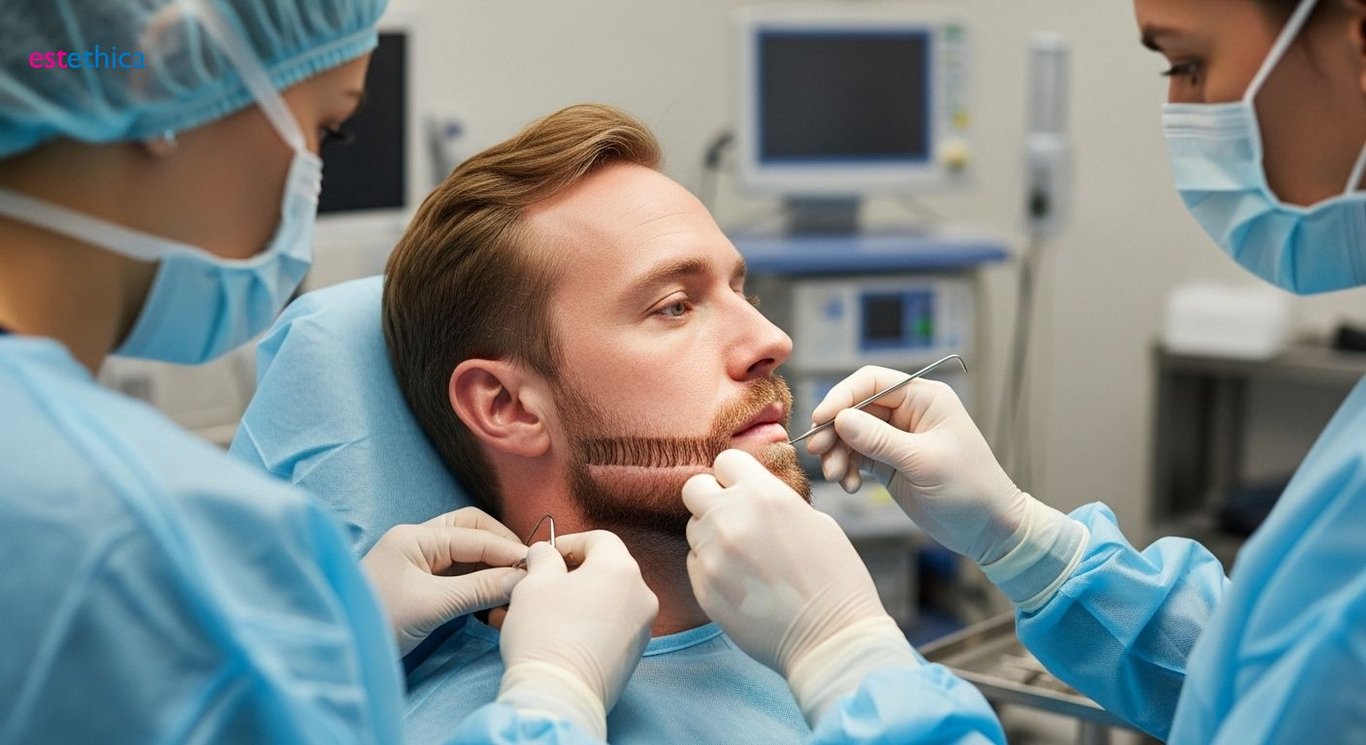Beard Restoration: Achieve the Perfect Facial Hair
Unlock your dream beard with facial hair transplant techniques like FUE and DHI. Get the scoop on what to expect before and after the procedure.
The pursuit of a fuller, well-defined beard is now more accessible than ever with advanced facial hair transplant techniques. This comprehensive guide delves into everything you need to know about beard restoration, from understanding the fundamentals to exploring cutting-edge transplant methods like FUE and DHI.
Beard Restoration 101: Understanding the Basics
The Core Principles of Facial Hair Transplant
Facial hair transplantation is transforming the aesthetic options available for men. The procedure focuses on restoring or creating a beard, mustache, or sideburns through hair follicle transplantation. This technique is especially beneficial for men with sparse facial hair due to genetics, scarring, or previous surgeries. Beard restoration enhances facial aesthetics by providing a fuller, more defined look. The transplanted hair integrates naturally, providing a permanent solution to patchy or thin facial hair.
- Natural Look: The transplanted hair grows in the same manner as existing facial hair, creating a seamless appearance.
- Permanent Solution: Once the transplanted follicles take root, they are permanent and grow like regular facial hair.
- Customizable: The procedure can be tailored to match the patient's desired beard style, density, and shape.
The popularity of facial hair transplants reflects a growing trend in men's grooming and aesthetic enhancements. Men are increasingly seeking ways to improve their appearance and boost their self-confidence through procedures like beard restoration. Facial hair transplant offers a tailored approach to achieving a fuller, more masculine look, addressing specific aesthetic goals. The success of the procedure depends on factors such as the surgeon's expertise, the patient's hair characteristics, and the chosen transplantation technique.
Techniques Used in Modern Beard Transplants
Modern beard transplants use advanced techniques to ensure natural-looking and lasting results. Follicular Unit Extraction (FUE) is a common method where individual hair follicles are extracted from the donor area, usually the back of the scalp, and transplanted to the beard area. Another technique is Direct Hair Implantation (DHI), a refined version of FUE, which uses a specialized pen-like tool to implant the hair follicles directly into the skin. These techniques minimize scarring and provide precise control over the placement and angle of each hair follicle, resulting in a natural-looking beard.
- Consultation and Planning: A detailed consultation to assess the patient's facial structure and desired beard style.
- Follicle Extraction: Using FUE or DHI techniques to carefully remove hair follicles from the donor area.
- Implantation: Precise placement of follicles into the beard area to achieve the desired density and shape.
The choice of technique depends on the patient's specific needs and the surgeon's expertise. FUE is favored for its minimally invasive nature and reduced scarring, while DHI offers enhanced precision in follicle placement. The goal of both techniques is to create a natural-looking beard that complements the patient's facial features. The advancements in beard transplant technology have significantly improved the outcomes, making it a reliable option for men seeking facial hair restoration. The procedure is not just about adding hair; it's about enhancing the overall facial aesthetic to achieve a balanced and masculine appearance.

Facial Hair Transplant Techniques: FUE, DHI & More
Comparing FUE and DHI for Facial Hair Transplants
Follicular Unit Extraction (FUE) and Direct Hair Implantation (DHI) are the leading methods in facial hair transplantation, each with distinct advantages. FUE involves extracting individual hair follicles from a donor area, typically the scalp, and then transplanting them to the desired facial area. DHI, on the other hand, uses a specialized tool called a Choi Implanter pen, which allows surgeons to simultaneously extract and implant hair follicles. The choice between FUE and DHI depends on factors such as the patient's specific needs, the desired density of facial hair, and the surgeon's expertise. Both techniques aim to provide natural-looking and permanent results, enhancing the patient's facial aesthetics.
- FUE: Minimally invasive with faster healing times, suitable for larger areas.
- DHI: Enhanced precision in follicle placement, resulting in a more natural appearance.
- Customization: Both techniques can be tailored to match the patient's desired beard style and density.
The precision offered by DHI can be particularly beneficial for achieving a dense and natural-looking beard. FUE is often preferred for its ability to cover larger areas efficiently. The success of either method relies on the surgeon's skill in accurately placing the hair follicles at the correct angle and depth. Ultimately, both FUE and DHI represent advanced options for men seeking to enhance their facial hair.
Recovery and Aftercare Following Facial Hair Transplant
The recovery period following a facial hair transplant is crucial for ensuring the success of the procedure. Proper aftercare helps to minimize complications and promotes optimal hair growth. Patients can expect some redness and swelling in the treated area during the first few days after the transplant. Following the surgeon's instructions regarding medication, cleaning, and activity restrictions is essential. Most patients can resume their normal activities within a week, although strenuous exercise should be avoided for a few weeks. The transplanted hair follicles will initially shed before new hair growth begins, typically within a few months.
- Initial Healing: Redness and swelling subside within the first week.
- Hair Shedding: Transplanted hair falls out before new growth begins.
- New Growth: Noticeable hair growth starts within a few months.
Regular follow-up appointments with the surgeon are important to monitor progress and address any concerns. Patients should protect the transplanted area from direct sunlight and avoid harsh chemicals or styling products. A healthy lifestyle, including a balanced diet and proper hydration, supports hair growth and overall healing. With proper care and patience, the results of a facial hair transplant can be transformative, providing a fuller and more defined facial appearance.

Who is the Ideal Candidate for a Beard Transplant?
Assessing Candidacy for Facial Hair Restoration
The ideal candidate for a beard transplant is someone looking to enhance their facial aesthetics through fuller, more defined facial hair. This includes individuals with patchy or thin beards due to genetic factors, previous surgeries, or scarring. Candidates should have realistic expectations about the procedure and understand that the results depend on factors such as hair texture, skin type, and overall health. A thorough consultation with a qualified surgeon is essential to determine suitability and discuss the potential outcomes. A successful facial hair transplant can significantly boost self-confidence by creating a more masculine and balanced facial appearance. Approximately 85% of men who undergo beard transplants report satisfaction with the results, citing improved self-esteem and a more youthful look.
- Patchy Beard: Individuals with uneven or sparse beard growth.
- Scarring: Those with facial scars that prevent hair growth.
- Desired Density: Men seeking a thicker, fuller beard for aesthetic reasons.
Key Factors Influencing Beard Transplant Suitability
Several factors influence whether someone is a good candidate for beard restoration. Skin type plays a crucial role, as healthy skin is necessary for the transplanted follicles to thrive. Hair texture is also important; the donor hair should match the existing facial hair in terms of thickness and color for a natural look. Overall health is another consideration, as certain medical conditions or medications can affect the success of the transplant. A comprehensive evaluation by a skilled surgeon will assess these factors to determine the best approach. For instance, individuals with autoimmune diseases may not be suitable candidates due to the potential for complications. Ultimately, the goal is to ensure the patient achieves a natural and aesthetically pleasing result from their hair grafting beard.
- Skin Health: Healthy skin is essential for follicle survival.
- Hair Match: Donor hair should match existing facial hair.
- Overall Health: Medical conditions can impact transplant success.

Beard Transplant Before and After: What to Expect
Achieving Natural Results and Minimal Scarring
After undergoing a beard transplant, patients can anticipate results that closely mimic natural beard growth. Advanced techniques, particularly Direct Hair Implantation (DHI), allow for precise placement of hair follicles, ensuring they align with the natural direction and density of existing facial hair. This attention to detail results in a seamless blend, making it difficult to distinguish transplanted hair from native growth. The DHI method also minimizes scarring, as it involves smaller incisions and less trauma to the skin. Patients benefit from a fuller beard and an improved facial aesthetic without visible signs of surgery. The artistry of the surgeon plays a crucial role in achieving these natural-looking results. Approximately 90% of patients report high satisfaction with the naturalness of their beard transplant outcomes.
- Natural Alignment: Follicles are placed to match existing hair direction.
- Minimal Scarring: Advanced techniques reduce visible scars.
- Seamless Blend: Transplanted hair integrates naturally.
Navigating the Recovery Process and Care Instructions
The recovery period following a beard transplant is essential for ensuring optimal results and minimizing complications. Patients receive detailed aftercare instructions that include guidelines on cleaning the treated area, applying prescribed medications, and avoiding activities that could disrupt the healing process. Typically, patients should avoid strenuous exercise, direct sun exposure, and excessive touching or scratching of the transplanted area for the first few weeks. Adhering to these instructions promotes proper healing and ensures the survival of the newly transplanted follicles. Following these post-operative guidelines is crucial for achieving the best possible outcome. Consistent adherence to aftercare instructions can increase the success rate of the transplant by up to 20%.
- Gentle Cleaning: Regularly clean the treated area to prevent infection.
- Medication Adherence: Apply prescribed medications as directed.
- Activity Restrictions: Avoid strenuous activities and sun exposure.
Precision Facial Hair Restoration with FUE and DHI Techniques
estethica employs Follicular Unit Extraction (FUE) and Direct Hair Implantation (DHI) for precise beard transplants. FUE offers minimally invasive follicle extraction, while DHI uses the Choi Implanter pen for simultaneous extraction and implantation, ensuring natural-looking results tailored to individual needs.
estethica's surgeons possess extensive experience in facial hair transplantation, ensuring meticulous follicle placement and optimal hair density. The selection of FUE or DHI depends on the patient's specific needs and the surgeon's expertise, resulting in enhanced facial aesthetics.
Minimizing Scarring and Ensuring Optimal Healing in Beard Transplants
estethica prioritizes patient safety and optimal outcomes through detailed aftercare instructions and regular follow-up appointments. Patients receive guidance on cleaning, medication, and activity restrictions to minimize complications and promote successful hair growth.
estethica's commitment to natural-looking results and minimal scarring has led to high patient satisfaction. The clinic's precise follicle placement techniques and comprehensive aftercare ensure a seamless blend with existing facial hair.
Frequently Asked Questions
What is a beard transplant and how does beard restoration work?
What are the main techniques used in a facial hair transplant, like FUE and DHI?
What can I expect in a beard transplant before and after the procedure?
Who is considered an ideal candidate for a facial hair transplant procedure?
How does a FUE beard transplant compare to a DHI beard transplant?
Ready to discover the healthy beauty you deserve?
📞 Call Now for Your Free Consultation!